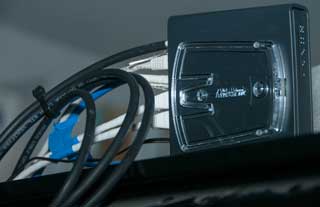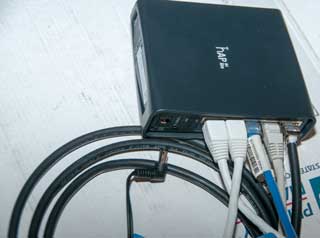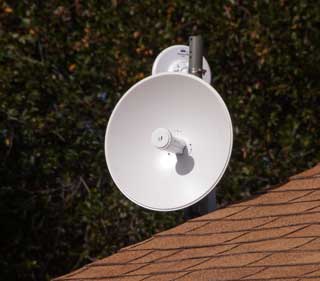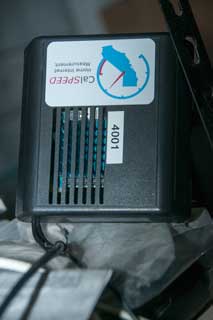Ubiquity NBE-2AC-13 2.4 GHz Wireless Point-to-Point Broadband
© Brooke Clarke 2019 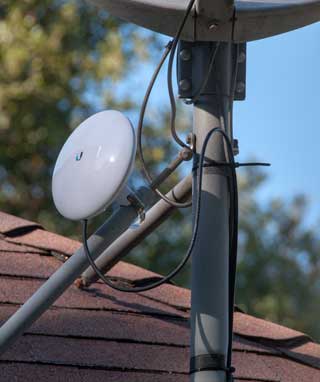 |
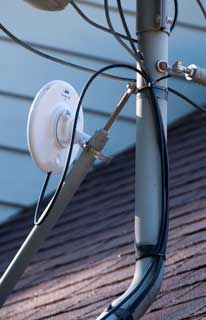 All the blue LEDs are lit. |
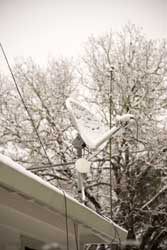 Notice no snow on antenna because of it's heat. |
History
Description
DC Power
Photos
Patents
Internet Status
Related
References
Links
Background
Started this web page when I got a WISP (Wiki) account.
History
Dial-up
When I first moved to Ukiah my internet connection was dial up. I went to their office and picked up the Netscape browser in a retail cardboard box and installed it. That got me email and the ability to browse. In a year or two Netscape added the "Composer" which was a WYSIWYG (Wiki) web page editor that allowed me to make web pages and store them in the 25 Mb of space I was allocated as part of my subscription. This meant that only very small thumbnail photo could be posted.
2-Way Satellite
Next, in 2001, came 2-way satellite (see: Starband). The biggest problem was a rolling 7-day data cap at 1 GB. I learned to work around the Solar outages (when the Sun moved to the same location as the satellite). But near the end the time for an eBay web page to load was very long (a coffee break made sense and you needed to think if you wanted to go to a web page because of the long delay).
DSL
In 2008 and 2009 I signed up for AT&T DSL but when the hardware arrived by mail and installed it did not work and tech support gave up and I sent it back in 2008 and again in 2009. I offered a service technician at the crossover box a lot of money if he could get me internet. He refused but told me AT&T must make it work. So the third time was the charm. I'm at the maximum line distance from the DSLAM for DSL so have poor service and buffering is handy for bathroom breaks.
Wireless Point-to-Point
2019 October 7: SeaKay (Happy Cycling LLC, BGPview) installed a dish on my next door neighbor's house and later installed a small dish on my house. Their Tier 1 (slowest) service is 3 M bits per second up (6X the DSL speed) and 6 M bits per second down (3X the DSL speed). The jitter and latency are about the same as DSL. This, like each of the above changes is a huge improvement.
Description
Ubiquity NBE-2AC-13 NanoBeam AC gen 2
The under 8" diameter dish houses all the electronics. These come in 2.4 GHz and 5.8 Ghz versions, where the 2.4 GHz version is used here because the path is through trees. The "2" in 2AC signifies the 2 Ghz band rather than the 5 GHz band. the "AC" is the newest generation that makes use of TDMA (Wiki) as opposed to the WiFi technique of FDMA (Wiki). Note cell phones started out using FDMA but soon upgraded to TDMA since it has many advantages that also apply to this application.
The LAN (Wiki) cable has 4 pairs of wire. 2 pairs are used for transmit data and normally the remaining 2 pair are not used. But in a Power over Ethernet Wiki: PoE) system the normally unused pairs are used to signal that there is PoE and to supply a nominal 48 VDC to the load device, in this case the antenna assembly.
MikroTik hAP ac lite Router & WiFi
WiFi: two 2.4 GHz ports and one 5.8 GHz port.
The AT&T and D-Link DSL modems provides a few LAN ports as well as WiFi for my house. This function was replaced by the MikroTik hAP ac lite. It also supports PoE out on Port-5 to power the Ubiquity dish. The DC input can come from a wall wart rated at 10 to 28 VDC at up to 0.5 Amps or through PoE input on Port-1. The wall wart should be rated at 24 VDC 1.2 Amps according to their brochure (I have not yet unplugged it to see). It also supports both 2.4 and 5.8 Ghz WiFi.
DC power
PG&E Planned Power Outage
Yesterday (because of the planned power outage) I got a robo call from pg&e asking me to go to a web page and enter a very long security key which I could not remember, but tried to write down. Today I received that same call, this time with better audio quality, but the at the 6th character the key was different. That does not matter because as of 1 pm 2019 October 8 the whole pg&e web site is down. What they have done amounts to a DDoS attack (Wiki) on themselves by asking half of California to go to their web page. This seems stupid since the outgoing message is going to people where they already know the address, i.e. instead of asking people to go to pge.com and look up a secret key, they could just send the information they would find out in the message.
This brings up the question: What happens to my internet service when it's fed from a wireless point-to-point network? There's a relay on my neighbor's roof that probably has a very short term battery backup (2 hours). I don't know how many other relays are in series (none). SeaKay says some of their towers have battery and or generator backup (my path does). They ass-u-me that the fiber optic service providers that feed them have batteries and generators, but . . . no one knows what will happen if half of California is shut down at the same time.
The DSLAM that feeds my DSL account has a backup battery good for an hour or two and the capability of adding a generator.
PS I'm keeping the DSL account until I have had some experience with this WISP (Wiki) account.
It turns out that the PG&E shutdown the night of 8 October drained the small battery on my neighbors system and so I don't have that system.
BUT . . . DSL is provisioned on top of a plain copper pair telephone circuit and that phone circuit falls under FCC Title II. That means it needs to work during an AC power failure. My DSL failed around 8am, but by around 8:30am was back up based on at&t adding a generator.
The second PG&E PSPS power outage started about 7:05 pm 2019 October 26. The battery in my neighbors system went dead around 9:40 pm, i.e. it lasted about 2-1/2 hours. After that I had no internet. The battery in the AT&T DSLAM must have a life that's even less. But the next morning the AT&T DSL was working. They must have learned from the last PG&E PSPS outage and brought the generator out sooner than last time.
I'm trying to learn the min and max allowable voltage for the Ubiquity dish and the currents that are associated with those voltages to design a backup power supply.
2019 October 28 after a few days of back and forth on the Ubiquity forum all I could learn was what was in the data sheet for the NanoBeam 2AC-13 , i.e. it runs on 24 VDC with current draw of up to 0.5 Amps. Note if the half Amp was at 24V the power would be 12 Watts, but there's a separate spec saying 7.5 Watts max. That implies the current at 24 V is more like 312 mA.
That would be consistent with a switching mode power supply.
The wall wart associated with the Router is rated 24VDC <= 1.2 Amps, or almost 29 Watts. That seems optimistic.
It may be that a 12V LiFePO4 battery and associated solar panel & charge controller would work? If not then maybe an 18 Volt version?
DC Battery Supply
The hAP ac lite Access Point just passes the DC power it gets in just goes to it's output. The standard Power Over Ethernet (Wiki) voltage is nominally 48 VDC which would burn out the Ubiquity equipment. Note that Starlink uses 56V for their Dish and Router. This means it would be best to supply it with 24 VDC, but nothing higher. Also the NBE-2AC-13 has an upper limit on input voltage of 25 VDC. This suggests that the most efficient back-up system would supply 24 VDC from a UPS. Similar to the Belkin 12V, or maybe 2 of the Belkin units connected in series (though that has a kluge aspect). So far I have not found any ready made UPS units with just 24 VDC out. Better than a 24 VDC UPS would be an 18 VDC UPS. The reason is that a 24 VDC system at full charging may exceed 25 VDC. For example a Li-Ion cell has a nominal voltage of 3.7 VDC charged and sitting without connection to anything. But during charging the cell voltage climbs to 4.2 Volts.
Lithium Battery Table
# Cells
Nominal
VDC
Min
VDC
Max
VDC
1
4
3.7
4.2
3
12
11.1
12.6
4
16
14.8
16.8
5
20
18.5
21.0
6
24
22.2
25.2
7
28
25.9
29.4
8
32
29.6
33.6 12
48
44.4
50.4
13
52
48.1
54.6
Bold Red for exceeds maximum DC allowed input Voltage to Ubiquity NBE-2AC-13
So Lithium batteries are not a good fit. Lead Acid batteries nominal voltage is the discharged voltage, so for example a "24 Volt" LA battery would be dead when it's voltage was 24.0 Volts. But when charged it's more likely to be at about 27.2 Volts. Way too high for the WISP system.
Idea Backup System
A battery backup system for the Ubiquity equipment would need to include a Switching Mode Power Supply (Wiki) to keep the output voltage compatible with the Ubiquity DC input requirements. One of the low cost LM2596 units might work (4 - 40V input, 2 - 35 V output).
An ideal backup system would include solar panels that deliver about 12 Watts, A MPPT charge controller for Li-FePO4 batteries. An output voltage regulator.
Photos
Fig 1 new dish mounted to leg of old 2-way satellite system.
Fig 2 Blue LEDs on back
Fig 3 Neighbor's Relay
The large dish points to the SeaKay tower. The smaller dish in back looks like the same one as on my roof and points to it. Note the bubble level at top center and the blue LEDs at about10 O'clock, just like Fig 2 at the left.
There is no backup in this setup so it fails with AC power shutdown.
Fig 4 at&t DSL backup generator 9 Oct 2019
Patents
8466847 Microwave system, Ubiquiti Inc, Priority: 2009-06-04, Pub: 2013-06-18 - integrating receiver and antenna (this was done in the satellite TV business decades ago) and using PoE type LAN cable to/from the antenna assembly.
Cited by (19 as of October 2019) patents, most of which are by Ubiquiti Inc. for improved versions.10418718 Antenna assembly for long-range high-speed wireless communications, Ubiquiti Inc, Priority: 2012-04-06, Pub: 2019-09-17 - mainly about the modular mechanical construction
Internet Status
CalSPEED Home Broadband Study
November 2019: I have a box from CalSPEED Home Broadband Study that monitors my at&t DSL internet connection and phones home to report the quality of my service. As part of the installation process I had my desktop WIN7 computer connected and there was a connection failure. After calling at&t tech support I found out that "they were aware my internet was not working and the repair should be by 9". So connected my computer to the WISP account.
Clicking on View the data I notice there is oneAT&T customer with poorer service than I have and over a dozen with much better service (some with 50 down). The two Frontier customers have very erratic service. If you live in California you can apply to be part of this survey.
The box checks the wired internet connection once every 4 hours and the WiFi internet connection once every 4 hours on an interleaved basis so there's a short test once every 2 hours. BUT . . this missed a major at&t outage that I noticed on 2019 November 5 around 2 pm.
CalSPEED Home Internet Measurement
This is similar to the problem with by back-up generator. The interlock switch requires turning off the house main breaker prior to connecting the circuit for the generator to the house. The only way to tell when the electric power grid is back on is to look at the electric meter for at least 10 seconds so see if it's on. I forgot to get the Power Back On alarm prior to the electricians installing the interlock and generator plug. So far my neighbors phone me since they know when their lights come on and the still hear my generator.
This brings up the need for a way to easily tell from 20 feet away from the boxes (DSL & WISP) if they are working or not.
ESP8266 Internet Alarm - This will not work for me. All it does is monitor the WiFi status and alarms with WiFi is down.
Fingbox - in addition to comprehensive TS it includes some security measures. $99
Monitor-IO - back light color reflects status, display and app give a lot of details. Comprehensive troubleshooting to confirm source of problem. $129
Related
Starband V-Sat internet service
at&t DSL service
Rural Internet
VOIP telephone service
Telephones
Telephone Poles
References
Links
PRC68, Alphanumeric Index of Web pages, Contact, Products for Sale
Page Created 2019 Oct 7
